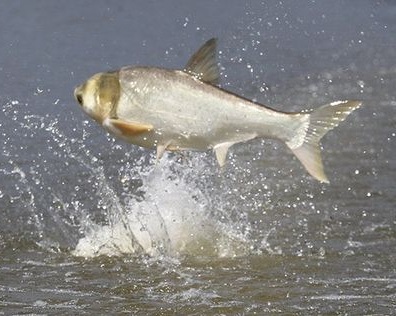 The Arkansas Game and Fish Commission will open a special commercial fishing season on Lake Chicot to target Asian carp from Nov. 1-Dec. 31. Asian carp, particularly silver carp and bighead carp have been a nuisance to many waters connected to the Arkansas and Mississippi Rivers since their escape from aquaculture and research facilities during floods in the 1970s. In addition to consuming vast amounts of plankton, which are the base of the food chain in many fisheries, silver carp have become a hazard on many waters where they are abundant because of their habit of jumping out of the water when startled.
The Arkansas Game and Fish Commission will open a special commercial fishing season on Lake Chicot to target Asian carp from Nov. 1-Dec. 31. Asian carp, particularly silver carp and bighead carp have been a nuisance to many waters connected to the Arkansas and Mississippi Rivers since their escape from aquaculture and research facilities during floods in the 1970s. In addition to consuming vast amounts of plankton, which are the base of the food chain in many fisheries, silver carp have become a hazard on many waters where they are abundant because of their habit of jumping out of the water when startled.
Asian carp are one of the species biologists hope to prevent from spreading to new waters through the recently instituted ban on transporting live, wild caught bait.
“Young silver carp look similar to gizzard shad, and when someone who doesn’t know the difference throws a cast net below dams in the Arkansas River and other areas where the carp are found, there’s a chance of them being mixed in with the hundreds of shad that are caught,” said Bill Posey, AGFC assistant chief of fisheries, during the proposal of the new regulation. “Zebra mussels and a host of parasites and diseases also may be transported in perfectly healthy-looking fish when they’re taken from one body of water to the next as well.”
Lake Chicot has seen an increasing risk of danger to boaters from the silver carp since they were first found in the lake just over a decade ago.
“The first instance of Asian carp found in Chicot was during a population sample in 2005,” said Diana Andrews, AGFC regional fisheries supervisor in Monticello. “By 2007, they had grown large enough to cause conflicts with boating and recreation on the lake.”
Andrews says at least one pleasure boater has been seriously injured by the jumping fish, and many more reports have come in from boaters and anglers who have had fish wind up in their boat or near misses.
“One boy was struck while tubing back in 2008 so badly that the impact knocked him unconscious and broke his jaw.”
Thankfully, silver carp are not capable of reproducing in Lake Chicot, but they are abundant in the Mississippi River, which originally created the lake. When floods overtop the dams of the oxbow, many species of fish flush into the system, including the silver carp. The recent floods during 2016 completely overtopped the dam, which gave many non-native fish the opportunity to spread into the lake.
“The silver carp population at Chicot does not seem to be as high as some oxbows on the Mississippi River, but it is still a serious nuisance and hazard on one of our best fishing and recreation lakes in Southeast Arkansas.”
Andrews hopes commercial anglers will be able to help remove some of the silver carp from Chicot during the special commercial fishing season, scheduled for November and December. Normally Chicot is off limits to commercial harvest, so many commercial anglers may find the lure of a new resource enticing.
“We’re allowing commercial anglers to keep any commercial fish except alligator gar they catch during the season, and we’re requiring all Asian carp caught to be removed,” Andrews said. “”In addition to the silver carp, good populations of catfish and buffalo should make a good incentive for anglers. We have also lifted the 16-inch minimum length on buffalo during the season to make it easier on our commercial anglers to make some profit while helping us remove the nuisance fish.”
Andrews says a plant in Mississippi that processed the silver carp for exported food recently closed, but other plants that manufacture pet foods still pay for the fish as a protein base.
Commercial anglers should contact the Monticello Regional Office at 877-367-3559 to obtain a free permit to participate in the special season.
“We want to track how effective this effort is in removing the fish and how many anglers participate,” Andrews said. “If it’s successful, we can look at expanding these sorts of efforts in the future.”
